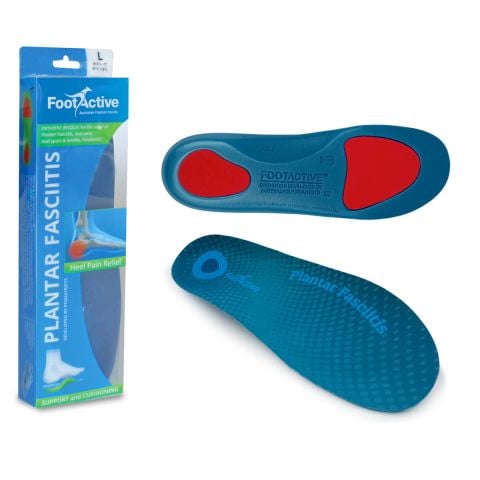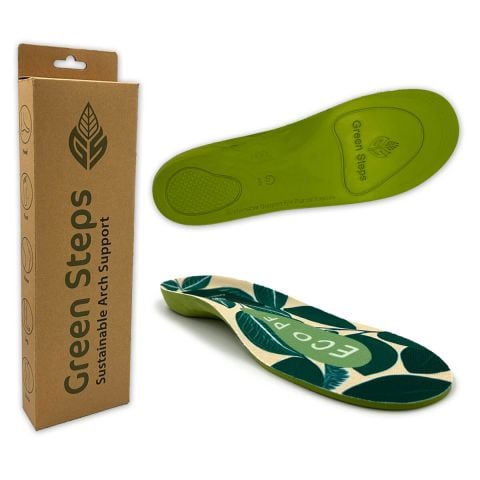Treating A Painful Plantar Fascia Effectively
Once you’ve established that you’ve got Plantar Fasciitis, you’ll need to take steps to reduce the pain and prevent further damage to your Plantar Fascia. One of the most highly recommended options for treating a painful Plantar Fascia is an orthotic insole. This will correct your posture, by re-aligning the foot, ankle and lower leg muscles. Many people with pain in their Plantar Fascia are simply suffering from fallen arches, where the arch of the foot flattens when you walk, which can easily be corrected by wearing the right orthotic insoles.
View Plantar Fasciitis Insoles
Orthotic Treatment for Plantar Fasciitis
There are a variety of options available for orthotic treatment. You can have a custom-made insole by visiting your GP, or podiatrist, or you can simply purchase standard orthotics for Plantar Fasciitis, arch support and correction. Custom made devices are usually more expensive and are often unnecessary, as several studies have found that Plantar Fascia pain can be relieved just as effectively with a standard orthotic. Failing to address a fallen arch can cause many problems later on in life, including knee and hip problems due to misalignment and strain on the muscles.
Other Options for Plantar Fasciitis Relief
As well as wearing your orthotics every time you go out, whether you are going to be exercising or simply going shopping, you might need to complete some stretching exercises to strengthen the muscles. If you have a severe Plantar Fascia injury and it is too painful to walk, you should limit the time you spend moving around to give your muscles time to heal. Taking anti-inflammatory pain relief medication, and applying ice to the painful area, is another solution to help reduce pain in your Plantar Fascia after exercising.
In extreme cases, an operation may be necessary to help your damaged Plantar Fascia heal. However, for most people with Plantar Fasciitis, this is not necessary and other treatment methods will always be taken first.
To prevent damage to your muscles when exercising, you’ll need to make sure that you are stretching properly and wearing shoes with an appropriate amount of support for your ankles and heels. If you have any questions or simply seeking advice, please do feel free to contact us.
Plantar Fasciitis FAQs
How do I know if I have Plantar Fasciitis?
The most common complaint of people with Plantar Fasciitis is pain on the bottom of the heel. It usually affects one foot but can sometimes affect both.
What causes Plantar Fasciitis?
There are many contributing factors to Plantar Fasciitis. These include:
- Flat Feet
- High Arches
- Obesity
- Shortened Achilles Tendon
- Over-Pronation
- Improper Footwear (particularly during intense exercise)
- Tight Muscles
What is commonly mistaken for Plantar Fasciitis?
Common foot conditions that are often mistaken for Plantar Fasciitis include: Arthritis, Nerve Entrapment, Stress Fractures, Sciatica, Achilles Tendonitis.
Foot Active arch support insoles help with a range of different foot conditions, so speak to our expert team who will be able to advise further on the best insoles for Plantar Fasciitis support and foot pain. If pain continues after using recommended treatment and products, we would recommend speaking to a medical professional to find out exactly what foot problem you are experiencing.
Why does Plantar Fasciitis hurt?
Plantar Fasciitis causes foot pain because the Plantar Fascia tendon has been over stretched. This causes micro-tears in the tendon which become inflamed.
Why does Plantar Fasciitis hurt more first thing in the morning?
People suffering from Plantar Fasciitis find it more painful in the morning because the tendon has become shortened during the night (or periods of inactivity) and is not being stretched. When you first get up in the morning and put weight on your feet the tendon is immediately stretched and this will cause some pain.
Does Plantar Fasciitis cause ankle pain?
It is possible to experience ankle pain as a result of inflammation of the plantar fascia radiating into the ankle.
What can I do to help with Plantar Fasciitis?
There are a few things you can do to help:
- FootActive insoles. Using a pair of FootActive Insoles will support the arch and stabilise the heel. Supporting the arch is vital as this will take the pressure off the Plantar Fascia tendon and stop the over stretching.
- Choose the right orthopaedic footwear with arch support, particularly sports shoes to reduce pressure on the foot when exercising.
- Wear Plantar Fasciitis Socks. These offer compression to the entire foot to relieve foot pain, reduce swelling, and can be worn alongside arch support insoles for maximum support and comfort.
- Stretching exercises. Please see our helpful videos here.
- Anti-Inflammatories such as Ibuprofen
How do insoles help with Plantar Fasciitis?
FootActive insoles help with Plantar Fasciitis by supporting the arch of the foot and stabilising the heel. This stops the foot rolling inwards and also supports the fascia tendon.
How do stretching exercises help with Plantar Fasciitis?
Stretching can help as quite often tight calf muscles or Achilles Tendons can contribute to Plantar Fasciitis. Please see our stretching videos.
How long does Plantar Fasciitis last for?
Unfortunately, there is no exact timescale as everyone is different. Over 90% of cases should go away with the use of home remedies such as shoe inserts for Plantar Fasciitis, stretching and massage. If problems do persist or get worse, please consult your GP.






 What is Plantar Fasciitis?
What is Plantar Fasciitis?